
The Noctuidae, commonly known as owlet moths, cutworms or armyworms, are a family of moths. They are considered the most controversial family in the superfamily Noctuoidea because many of the clades are constantly changing, along with the other families of the Noctuoidea. It was considered the largest family in Lepidoptera for a long time, but after regrouping Lymantriinae, Catocalinae and Calpinae within the family Erebidae, the latter holds this title now. Currently, Noctuidae is the second largest family in Noctuoidea, with about 1,089 genera and 11,772 species. This classification is still contingent, as more changes continue to appear between Noctuidae and Erebidae.

Schinia, commonly called flower moths, is a large genus of moths belonging to the family Noctuidae. The genus has a Holarctic distribution with the vast majority of species being found in North America, many with a very restricted range and larval food plant.
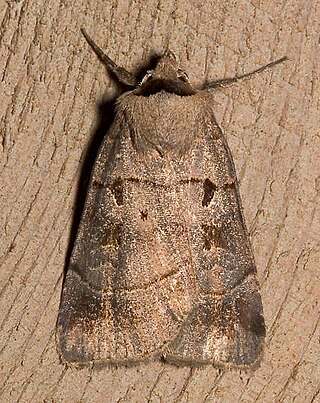
Agnorisma is a genus of moths of the family Noctuidae. Agnorisma species were formerly included in the genus Xestia.

Feralia jocosa, the jocose sallow or the joker moth, is a moth of the family Noctuidae. The species was first described by Achille Guenée in 1852. It is found from the northeastern parts of the United States south to Maryland and Ohio, north to Newfoundland and west across the boreal forest to coastal British Columbia. In the lower mainland and Vancouver Island the species is replaced by Feralia deceptiva.

The olive green cutworm or girdler moth is a species of moth of the family Noctuidae. It is found from Wisconsin and Manitoba to British Columbia, south to California and Arizona.
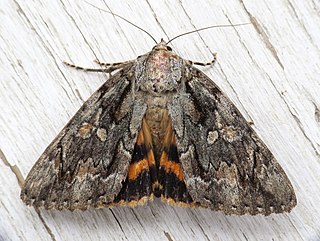
Catocala neogama, the bride, is an moth in the family Erebidae first described by James Edward Smith in 1797. It is found in North America east of the Rocky Mountains, from Maine and Quebec south to northern Florida and west to South Dakota, New Mexico, and into Arizona and Texas. Its westernmost population from the semiarid Colorado Plateau region is rather distinct and was once considered a separate species, but is now regarded as a well-marked subspecies C. n. euphemia.

Acronicta longa, the long-winged dagger moth, is a moth of the family Noctuidae. The species was first described by Achille Guenée in 1852. It is found across much of North America, with Nova Scotia, Alberta, Florida, and Texas within is range.

Acronicta hamamelis, the witch hazel dagger moth or puzzling dagger moth, is a moth of the family Noctuidae. The species was first described by Achille Guenée in 1852. It is found in Canada and parts of the United States, including Maryland.
Agnorisma bugrai, the collard dart, is a moth of the family Noctuidae. The species was first described by Ahmet Ömer Koçak in 1983. It has a transcontinental distribution in North America, from central Canada and the northern United States, southward in the Rocky Mountains to Colorado.

Agnorisma badinodis is a moth of the family Noctuidae. It is found in southern Canada and United States, east of the 100th meridian, and exclusive of the Deep South.

Acronicta modica, the hesitant dagger, is a moth of the family Noctuidae. It is found in eastern North America from Nova Scotia to Florida, west to Oklahoma and Texas.

Raphia frater, the brother moth or simply the brother, is a moth of the family Noctuidae. It is found from Nova Scotia west, across the forested regions of Canada to British Columbia, south to Mississippi in the east. The southern limits in the west are uncertain due to confusion with several closely related species or forms.

Heliothinae is a small, cosmopolitan subfamily of moths in the family Noctuidae, with about 400 described species worldwide. It includes a number of economically significant agricultural pest species, such as Helicoverpa armigera and Helicoverpa zea.

Schinia nubila, the camphorweed flower moth or brown flower moth, is a moth of the family Noctuidae. The species was first described by Herman Strecker in 1876. It is found from the US states of Oklahoma to New Jersey, south to Florida and Texas. Its range is expanding in the northeast. Furthermore, recorded from Colorado, Kansas, Oklahoma, Arkansas, North Carolina, South Carolina and Maryland.
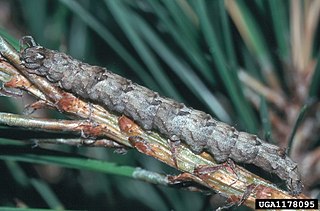
Zale metatoides, the washed-out zale or jack pine false looper, is a moth of the family Noctuidae. The species was first described by James Halliday McDunnough in 1943. It is found in barrens and pine woodlands from at least Wisconsin and probably Manitoba to Maine, south to the mountains of Georgia. The range in the Gulf States is not certain.

The Erebidae are a family of moths in the superfamily Noctuoidea. The family is among the largest families of moths by species count and contains a wide variety of well-known macromoth groups. The family includes the underwings (Catocala); litter moths (Herminiinae); tiger, lichen, and wasp moths (Arctiinae); tussock moths (Lymantriinae), including the arctic woolly bear moth ; piercing moths ; micronoctuoid moths (Micronoctuini); snout moths (Hypeninae); and zales, though many of these common names can also refer to moths outside the Erebidae. Some of the erebid moths are called owlets.
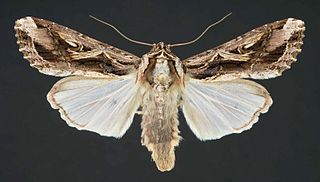
Spodoptera dolichos, the dolichos armyworm moth or sweetpotato armyworm moth, is a moth of the family Noctuidae. The species was first described by Johan Christian Fabricius in 1794. It is found from the southern United States, south through Costa Rica to South America, as far south as Argentina. In the United States, it may occur as far north as Kentucky and Maryland.
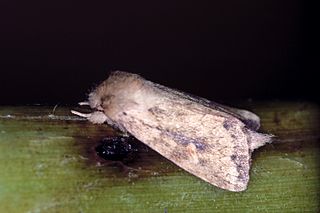
The pickerelweed borer moth is a species of moth of the family Noctuidae. It is found from Maryland to southern Florida, west to Indiana and Louisiana.
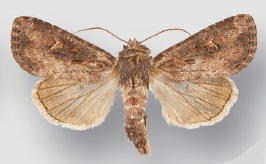
Resapamea passer, the dock rustic moth, is a moth in the family Noctuidae. It is found from central Alberta to northern Arizona in the Rocky Mountain region. In the mid-Continent it ranges from Minnesota and southern Ontario to Oklahoma and North Carolina, reaching the Atlantic Coast from Newfoundland to Maryland. The habitat consists of wetlands.

Noctuina is a subtribe of cutworm or dart moths in the family Noctuidae. There are at least 170 described species in Noctuina.
















